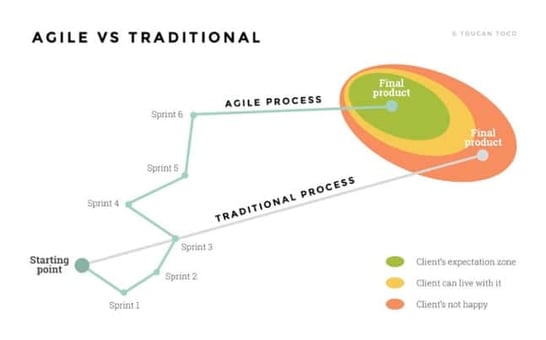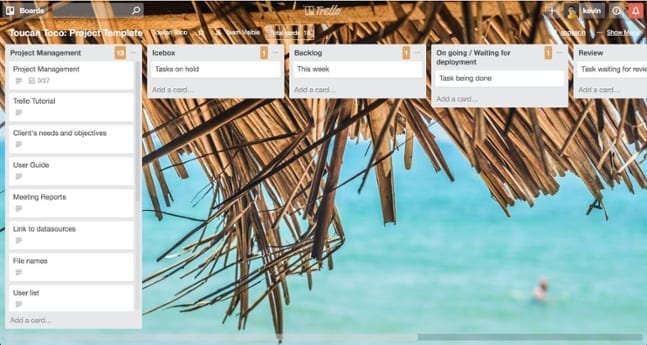
At Toucan Toco, we build applications that visualize data through animated charts. Put simply, we help companies make better decisions on a daily basis. When we landed a contract with Ubisoft, one of the biggest video game publishers in the world, we knew we needed to try something new and inspired. So we decided to take the “Lean Startup” theory and make it our own thanks to Trello.
Working with Ubisoft as a smaller provider, we wanted to maximize their satisfaction with our product configuration. Ubisoft needed a tool to track and compare the performance of their games with users. They also wanted to compare their product performance with other trending games in the market.
So, our goal was to visualize their data and give them insight into their position within both the retail and mobile markets. We used our software to create an app that turned their data into beautiful and easy to understand charts. But it wasn’t a smooth ride from start to finish.
The way we ended up reaching that finished product—using Trello to execute a process we call agile software configuration—has become the trademark way we manage and execute projects.
Here’s how we used Trello to bring the startup mindset into an enterprise project, with some pretty neat results.
Don’t Go Chasing Waterfalls
Most traditional software companies manage projects using waterfall development. Once the customer hands over the brief, the software team goes in a development tunnel for months. When they deliver the project, it rarely meets the expectations of the clients. And the reason for these missed expectations is simple: the customer was never part of the development process.
Ubisoft was a turning point for our team. As we didn’t use the same process and tools as their team, we had a hard time running the project via our normal, iterative method. Having two different approaches created a lot of friction and made it difficult for us to collaborate.
The team at Ubisoft became frustrated. They felt the project wasn’t going anywhere because they could not see any evolution. In fact, we were working like crazy on their information systems but they had no way to know it.
We would have meetings, calls, and emails to trade information, but it was chaotic. They would give us feedback but had no way to check if we handled it until the production stage. It wasn’t comfortable for them and neither for us.
At this point, we realized that we weren’t agile in the way we communicated to each other. In other words, we lacked transparency and perspective.
Starting Over Lean (But Not Mean)
We decided to switch to an agile process as we wanted to make sure Ubisoft was fully satisfied with the way we integrated our product into their stack. We wanted to be completely confident that they would use the tools we were building for them, and those tools delivered everything they needed.
The strategy was to include the Ubisoft team’s feedback at the end of each sprint, rather than wait to show them a finished product:
During this type of agile process, we learned to expect twists and turns in the development plan as the client encountered and uncovered features they wanted, needed, or didn’t find valuable.
Trello Brings Perspective To The Process
Enter, Trello: We decided to use the collaboration tool for all communication. Our team and the Ubisoft teams would talk to each other through a Trello board to increase transparency and track feedback from sprint to sprint.
The goal was to reduce friction in all aspects: We decided to avoid calls, meetings, and emails as much as possible. From then on, the only strategic change would be addressed in a meeting.
We now use our Trello board to educate people on our methodology. We take them through the process and show them how sprints work. We tell them what they should expect from us at every step of the project.
The following sample board shows our project development, from idea to validation. The most important column is the backlog where all client feedback is organized:
For example, Ubisoft would deliver feedback at the end of each two-week sprint. They were able to prioritize any feature or task at their convenience. They were having control on where the project was heading —exactly what we wanted.
This open-communication project management worked perfectly with Ubisoft. Communicating primarily through our shared project saved us time and increased the visibility of our work.
How We Run Agile Software Configuration In Trello
Each stage of the process is tracked as a list, with the various stages of the process organized like this:
- Icebox: This is where we needed Ubisoft to take action, such as giving us their data or granting us access to specific databases.
- Backlog: All Ubisoft requirements for the project are placed here and prioritized by them. They decide what we are to focus on and what are the key features to build.
- Ongoing / Waiting for deployment: This one is pretty much self-explanatory. It helps Ubisoft to know that we are working on the task. They can’t see it on the product as it is still on our environment, but they know it’s being managed.
- Review: This is where they give us feedback or confirm the work we do. No need for a call or email to get a status update!
Software Projects Made Simple
In our line of business, it’s not unusual for a project to take at least eight months to complete. Applying agile methodology with Trello helped us reduce that number to a three-month development time average.
Using Trello with Ubisoft helped them deliver accurate feedback and track every stage of project development while having the ability to prioritize the features they needed. With complete transparency on the overall project, they knew what we were doing and could shape the project as much as they wanted. The result was a product that fit their exact needs.
The goal of running a lean, startup-minded project workflow in Trello was to keep things simple, transparent and collaborative. We now use this methodology with every client, from startup to enterprise.
With less client friction, we work faster and the products and services we deliver are more accurate and of higher quality. The lean startup mindset is deceptively simple: find the best (read: most agile) way to communicate with your client.
__
Kilian Bazin, CEO and co-founder of Toucan Toco




